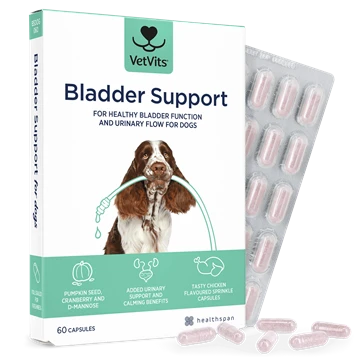Changes in your pet’s urinary habits are concerning as well as inconvenient. Alterations from their normal bladder movements, from needing to go more often to signs of discomfort or accidental leakage, are a clear signal that something may be wrong. As well as consulting your vet, there are practical ways that you can help support your pet. In this guide, we’ll explore common bladder issues among cats and dogs, as well as the possible causes and how to treat them.
🕒 5 min read
1. Signs of Pain or Discomfort
One of the most apparent signs of a bladder problem in cats or dogs is visible discomfort during urination. You might observe your pet straining, hunching their back, or even moaning in pain, which are clear indicators that they need veterinary assessment.
Possible causes:
- Urinary Tract Infections (UTIs): Water infections in dogs or cats occur when bacteria travel up the urethra and cause inflammation (cystitis). This irritation can lead to increasing pain during urination.
- Urinary Bladder Stones: Solid mineral crystals that form in the bladder and cause significant irritation and pain.
2. Blood in Their Urine
Blood in a cat or dog’s urine is a clear sign that something isn’t quite right. If you notice any variations from a normal, clear or pale-yellow colour, such as a pink or red tinge, you should immediately notify your vet.
Possible causes:
- Urinary Tract Infection: Inflammation of the bladder lining causes small blood vessels to rupture, leading to visible blood.
- Feline Lower Urinary Tract Disease (FLUTD): A range of conditions affecting a cat’s bladder, often linked to stress or crystals rather than bacteria.
- Urinary Bladder Cancer: Although rare, tumours in the bladder can present with similar signs of a urine infection in dogs, including straining and blood in the urine.
3. Incontinence
Urinary incontinence, the involuntary leakage of urine, can affect pets of any age, though it’s especially common in older dogs. This may be a sign of an underlying bladder weakness, and if your pet has started having accidents, the cause is more likely physical rather than behavioural.
Possible causes:
- Urinary Incontinence: An involuntary loss of bladder control caused by weakening of the sphincter muscles that manage urine flow, a common issue in senior pets.
4. They’re Urinating More Frequently
A noticeable change in how often your pet needs to empty their bladder is a key health indicator. A cat or dog peeing a lot is a common UTI symptom. In contrast, if you notice your dog struggling to pee or your cat not peeing at all, this could signify a blockage and should be treated as a veterinary emergency.
Possible causes:
- Kidney or Prostate Problems: Kidney issues can result in your cat or dog weeing lots of very dilute urine. In unneutered male dogs, an enlarged prostate can press on the urethra, making it difficult for them to urinate.
How to Support Your Pet’s Bladder Health
If you notice any changes to your pet’s urination, the first step is always to contact your vet for a professional diagnosis. Once you have done this, you can support your pet with a holistic, long-term care plan, using some of the suggestions below.
Ensure They Are Properly Hydrated
Maintaining good hydration is fundamental for your pet’s urinary wellness. Ensure that their water bowl is always topped up and that they’re visiting it throughout the day, especially during hotter weather. A consistent intake of fresh water helps to dilute urine, preventing the formation of crystals and the growth of harmful bacteria.
Optimise Their Diet
A balanced and nutrient-dense diet helps support your pet’s overall health, including their urinary system. For pets susceptible to bladder issues, incorporating wet food into their diet is a simple and effective method for increasing their daily water consumption.
Keep Their Space Clean
Environmental factors play a significant role in pet bladder health, especially for cats. A clean litter box situated in a calm, accessible area encourages regular use and helps prevent them from holding urine for extended periods, which can contribute to bladder problems.
Reduce Possible Stressors
Stress can physically impact your pet’s health, and the urinary system is particularly sensitive to it. Creating a stable, calm, and predictable home environment is beneficial for all pets and can help minimise stress-related flare-ups of urinary discomfort.
Use Supplements
Providing targeted nutritional support is a key pillar of proactive bladder care for cats and dogs. A high-quality supplement can help to maintain a healthy urinary environment, support the body’s natural inflammatory response, and promote overall comfort.
Bladder Support for Dogs
Supports urinary flow & bladder health | Pumpkin seed, cranberry & D-mannose | Calms & comforts | Promotes protection of the bladder lining | Tasty chicken-flavoured capsules
- Promotes healthy urinary flow and bladder comfort
- With pumpkin seed, cranberry, and D-mannose
- Helps protect the bladder lining and soothe irritation
Our expertly formulated bladder supplements for cats and dogs offer a synergistic blend of natural ingredients designed to work with your pet’s bladder, including:
- Pumpkin Seed: Naturally rich in fatty acids and antioxidants, pumpkin seeds help to support normal bladder muscle function and maintain healthy urinary control, particularly in mature pets.
- Cranberry Extract: Cranberries contain compounds called proanthocyanidins (PACs), which help to reduce the buildup of bacteria in your pet’s bladder wall, allowing them to flush out of their system naturally.
- D-Mannose: This naturally occurring sugar binds to E. coli bacteria, facilitating its removal from your cat or dog’s body during urination.
Bladder Support for Cats
Supports urinary flow & bladder health | Pumpkin seed, cranberry & D-mannose | Calms & comforts | Promotes protection of the bladder lining | Tasty chicken-flavoured capsules
- Promotes healthy urinary flow and bladder comfort
- With pumpkin seed, cranberry, and D-mannose
- Helps protect the bladder lining and soothe irritation
By staying alert to changes in your pet’s bladder habits and acting promptly, you can make a real difference to their comfort and long-term wellbeing. With your vet’s guidance, a combination of good hydration, balanced nutrition, a stress-free environment and targeted supplements can help protect urinary health at every life stage. Proactive care not only supports a healthy bladder but also helps your cat or dog enjoy a happier, more active life for years to come. Explore our full range of pet supplements.








